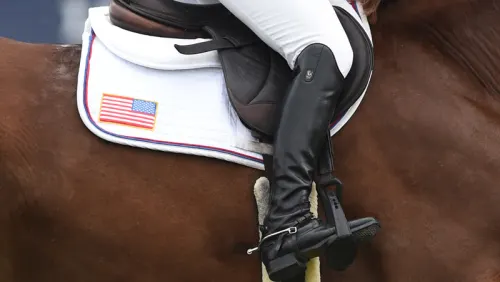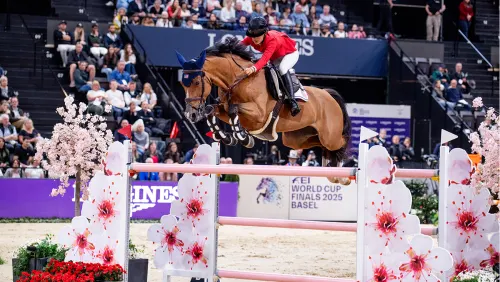A task force charged with updating the U.S. Equestrian Federation’s amateur rule has come up with a handful of suggestions intended to make it easier for riders to retain that status while receiving payment for work that is horse-related but doesn’t give them a competitive advantage over fellow amateurs.
Established in February of this year and made up of individuals form various breeds and disciplines, the U.S. Equestrian Federation Amateur Task Force examined the existing rules defining USEF amateur status and evaluated their relevancy in the current social-media climate. On Aug. 2, it hosted a webinar to present five suggestions that it hopes to receive public feedback on before creating an official rule change proposal.
“This is not cast in stone by any means,” said task force member Lisa Blackstone. “It is a work in progress, and we truly want your ideas and more discussion with all our stakeholders.
“All of us in this committee you will see have come from very different backgrounds in equine sport,” she added. “But we have very shared experiences regarding declining numbers that participate in our sport, a general lack of enthusiasm and awareness that this sport can be quite expensive. We feel it’s time our organization rethinks some of our old ideas and traditions. The time has passed, frankly.”
The amateur rules last underwent a major update in 2009.
“We need to evolve with the times to stay vital and relevant,” said Blackstone. “It’s a new world. So much has changed since this rule was first implemented. There was no such thing as social media back then. So we need to attract the younger demographic; we need to introduce equine sport to more people; we need to make it more accessible, more affordable and more fun.”
Instead of one sweeping rule change proposal, the task force divided its ideas into five potential changes. Here’s the breakdown:
#1: Allow Paid Barn Work
The exorbitant cost of showing is prohibitive to some. To help riders pay for their participation in the sport, and hopefully make it easier for more people to participate, the task force re-examined what paid horse-related jobs amateurs might be able to do while retaining their amateur status.
“We predicated our approach on what activities to allow by asking, ‘Does this activity give this amateur a competitive advantage over other amateurs that are not engaged in that activity?’ ” Blackstone said. “Because that’s what we want to avoid. We want to keep a level playing field for all the amateurs.”
The group proposed that amateurs be able to receive payment for “barn duties” such as: grooming, tacking up and untacking, bathing, clipping, lunging, braiding, and stall and tack cleaning. The change would take effect in 2022, pending approval.
“The thought behind it is an amateur could help out at shows, and maybe defray some of their show expenses, while also providing a lot of needed assistance to their trainer,” Blackstone said.
#2: OK Up-Down Lessons
ADVERTISEMENT
The task force’s second suggestion would allow amateurs to be paid to teach introductory lessons, under the direction of a professional. This proposal is radical departure from the current guidelines, but Blackstone said the ability to teach would have strict parameters: First, amateurs could only teach away from competition grounds. Second, teaching duties cannot be the person’s full-time job and would be limited to 20 hours weekly. Third, a weekly log would need to be maintained to record the amateur’s teaching hours and signed off by the professional, in case it is ever requested by U.S. Equestrian Federation.
“The hope is that this change will open the doors for new riders to get started—that’s the ultimate goal,” Blackstone said. “It’s expanding equine sport. And it allows a training barn to offer lessons and expand their business and therefore grow the number of people riding horses.”
However, the term “introductory lessons” is open-ended. As of now, each barn can define introductory to meet its own needs. But the task force wants suggestions on how to better clarify the phrase to make sure the amateur exemption isn’t abused.
“We thought about limiting introductory lessons to include people who have not shown at a USEF show, but there are other shows that do not fall into that category [so] that might be too permissive,” Blackstone said. “Ultimately, we decided to allow each professional barn to determine what an ‘introductory lesson’ is as within your own barn. Now that means the standard is not necessarily uniform. But we have yet to come up with a benchmark of confidence that best defines introductory lessons.”
USEF Director of National Breeds and Disciplines Terri Dolan said the proposal could be a way to limit show expenses for some amateurs in addition to helping professionals dealing with an influx of lessons.
Some individuals expressed concerns that the rule could be easily abused. Dolan acknowledged that possibility but pointed out that the current amateur rule also depends on an honor system.
“There will be violations to what we’re proposing,” Dolan said. “We understand that, and it will be investigated by the hearing committee, as it currently is. I don’t think you all as members want people policing everything that everyone does. You have to hope that people are going to do the right thing for the sport.”
#3: Welcome Social Media Influencers
Whether social media influencers should be considered amateurs caused great debate during the 2020 U.S. Hunter Jumper Association Annual Meeting where two opposing rule change proposals were brought to the table. The USEF Amateur Task Force addressed influencers in the rule revisions by suggesting eliminating current rule that caps amateurs at receiving $300 in remuneration.
“We think that social media is really an important story-telling device in the world today,” USEF Chief Marketing Officer Vicki Lowell said. “The more that we have individuals out there that can tell their stories well and can spread the word about our sport and about products in our sport, even as amateurs, I think is a positive for us.”
Social media ambassadors and social media influencers are different than the sponsored athlete, she said. The sponsored athlete is financially supported by companies to compete and is chosen by a company because of their athletic ability.
Meanwhile, social media influencers were defined as “people who have built a reputation for their knowledge, content creation and expertise on a specific topic” and post on their personal social media accounts. Brand ambassadors, similarly, are people who promote a company or brand on their own social media channels. While influencers and ambassadors may receive remuneration, it is not based on their competitive skills.
“It is really important that we look at this role as social media influencer and brand ambassador and consider that being a career or an extra part-time job that people can do and can still be amateurs within our sport,” Lowell said. “I think it will allow our sport to be more inclusive and more accessible and give people an opportunity to kind of move with the times of the social media environment.”
However, social media influencers and brand ambassadors would not be able to promote products or companies in a competitive setting, for example, wearing a saddle pad advertising a sponsor.
ADVERTISEMENT
“The goal of this again is to not to have amateurs promoting products on competition grounds or in competition,” Lowell said. “I think it’s really important that people understand that this is not a million-dollar business … [and] that it’s [not] going to create an unfair and unlevel playing field.”
#4: Increase The Junior Age Limit
The task force noted that horse show participation falls off after people reach their 18th birthday, and to combat that they suggested extending the junior age to 21 to encourage more and longer engagement with the sport.
“Some think this will help our college kids stay engaged, rather than us losing them at this transitional time in their lives, and give young adults the opportunity to test the waters, so to speak, about whether they want to participate in the sport as an amateur or as a professional,” Blackstone said.
Last year, complaints about the age splits in the amateur-owner hunter divisions reached the USHJA Annual Meeting, with more mature amateurs expressing discontent about showing against their younger counterparts. Although a proposal to divide the division into three age sections did not pass last year, task force member Penelope Ayers pointed out that amending the age of juniors would solve that problem.
“I think it’s important for amateurs to realize that we have tried many different ways to increase the older amateur age,” Ayers said. “One of the benefits of this for us, as older amateurs, is that by raising the junior age to 21, the automatic split will now be 22 and above for amateurs. So you’re going to see the next split—I don’t know what it would be, but I’m guessing it would be something like 42 or 44—so you’re going to see that age change, which is something we’ve needed in the amateurs for a really long time.”
The task force’s proposal to raise the minimum junior age would not apply equitation championships, which would remain at the current age cut off of 18.
#5: Let Young Adults Explore Turning Pro More Easily
Currently, if a young professional wants to reapply for amateur status, they must not compete in amateur divisions for 12 months afterward. The task force suggested changing the rule for people 25 and younger, so that they can—for one time only—reapply for amateur status and wait only three months to start competing again. This proposal is intended to prevent younger adults from being penalized for exploring and engaging in the sport in a professional setting.
Moving Forward
The USEF Amateur Task Force is still receiving feedback and tweaks on these suggestions. If the majority of the members approve for these changes, then they will most likely go through the extraordinary rule change process.
“There’s this burning platform to make changes to the rule that needs changes,” Dolan said. “We also know that we may not get everything right this first time around, and there may need to be some tweaks after we introduce these changes, and they get approved. There may be some tweaks that we need to make the following year with some of these. But not doing anything is not the right answer. It’s how do we try to listen to the members, all stakeholder groups that we’ve been hearing from, and the time is now to make the changes.”
Members that watch the webinar, linked here, can answer a survey to provide feedback.















